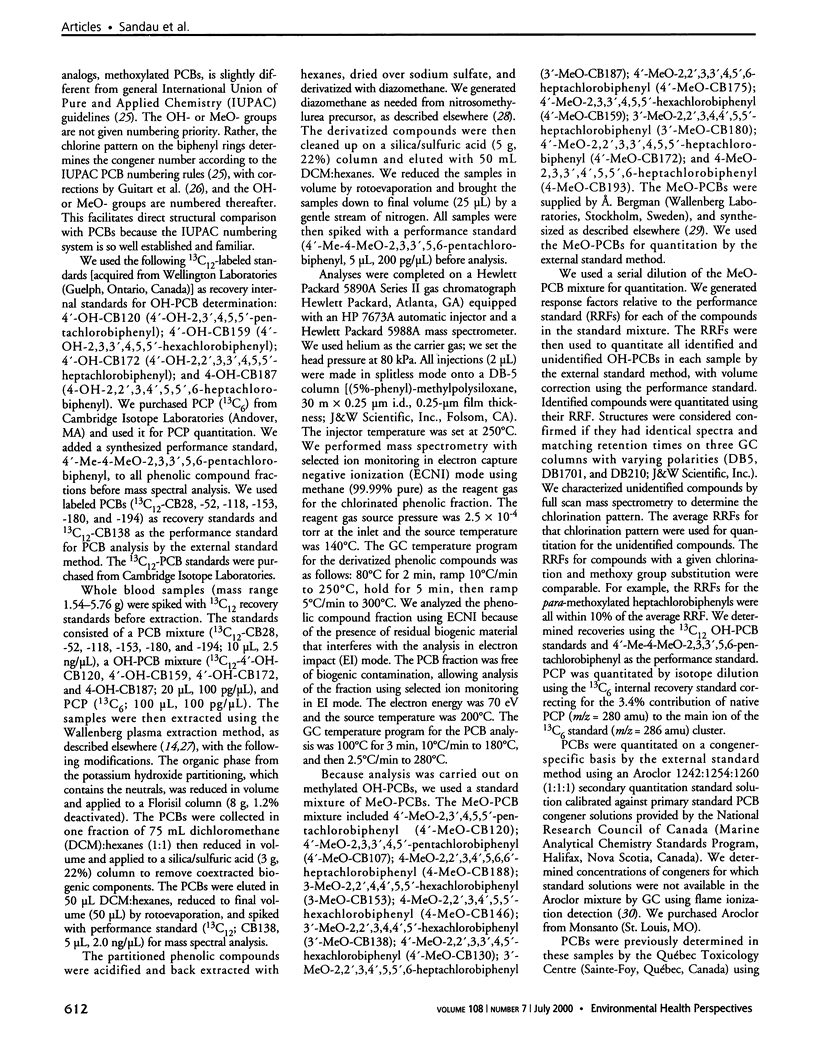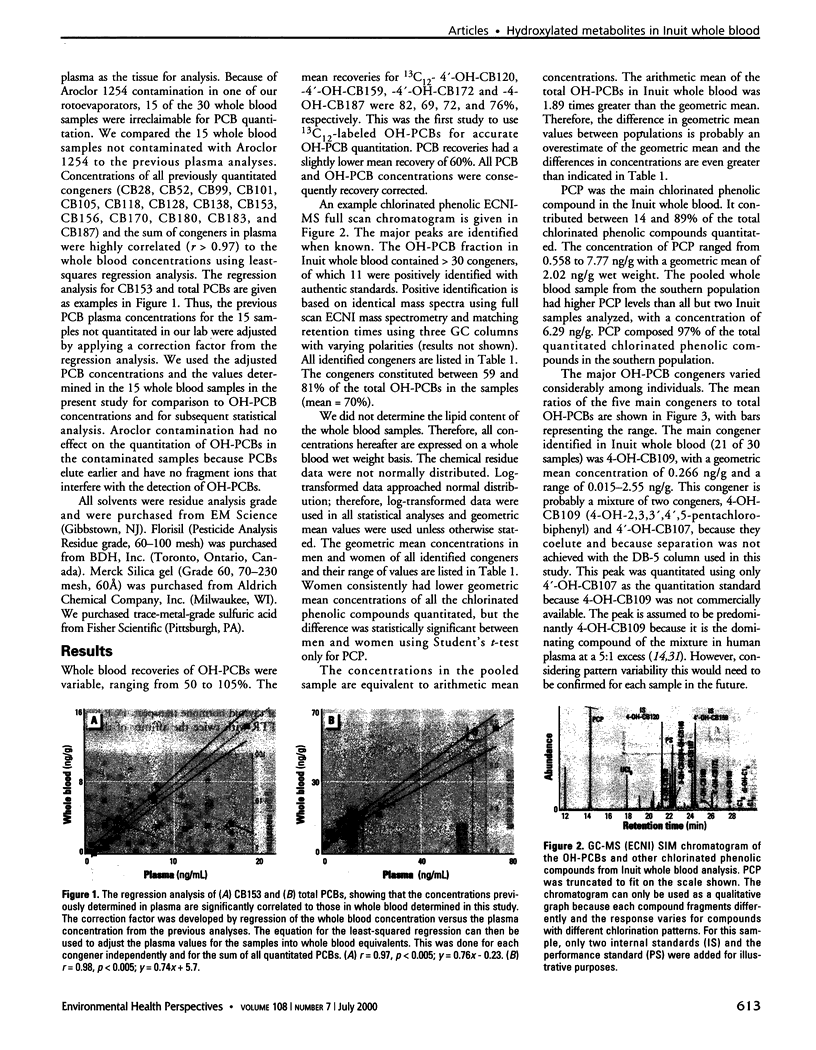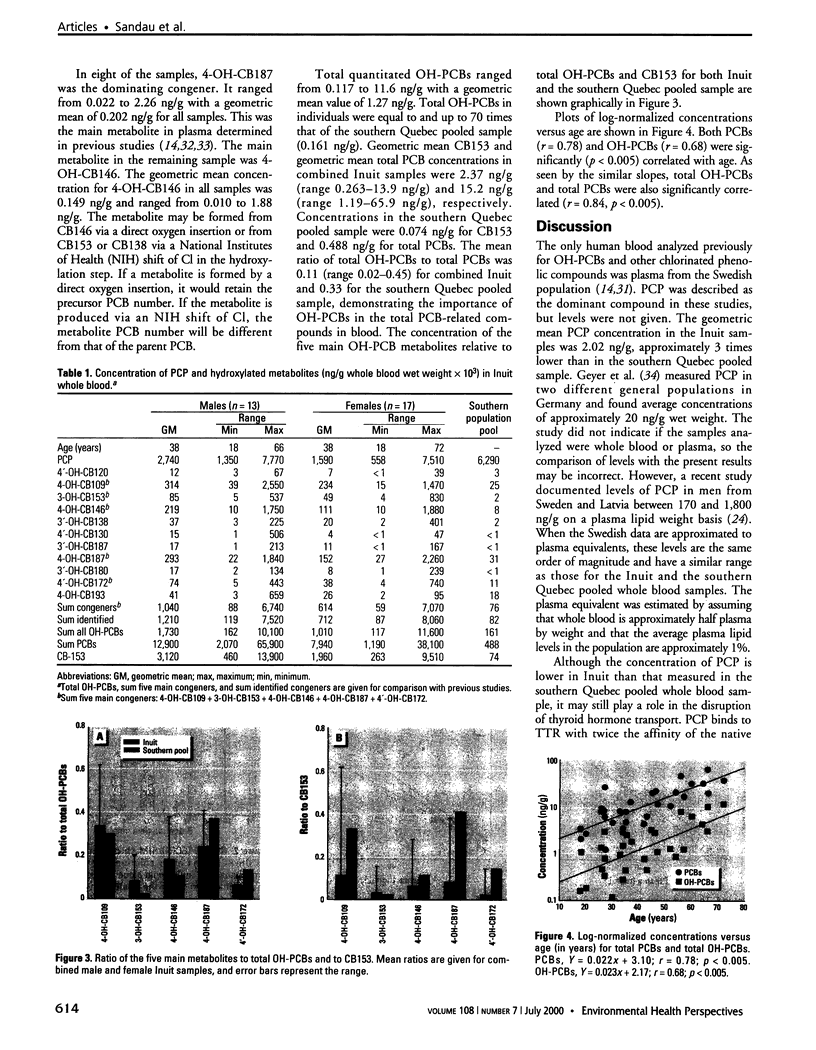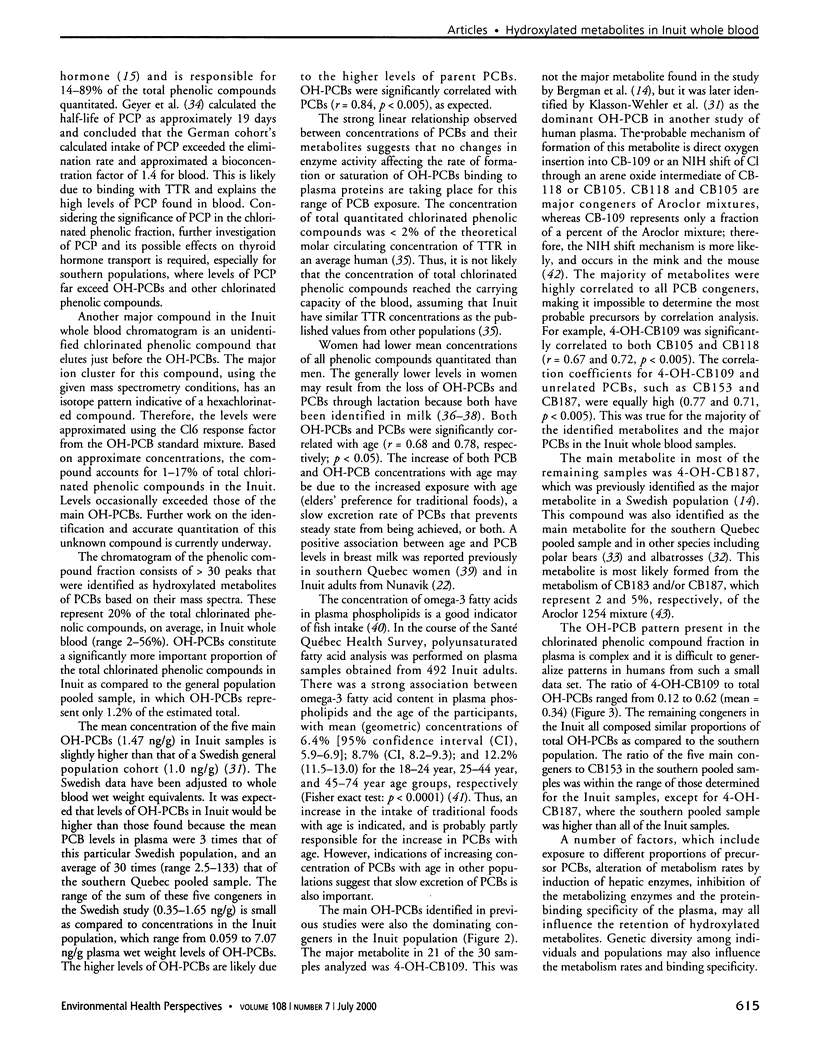Abstract
In this study, we identified the main hydroxylated polychlorinated biphenyls (OH-PCBs) and other chlorinated phenolic compounds and we determined their relative concentrations in whole blood from 13 male and 17 female Inuit from northern Quebec, Canada, and from a pooled whole blood sample from southern Quebec. We also determined concentrations of polychlorinated biphenyls (PCBs). Total OH-PCB concentrations were variable among the Inuit samples, ranging over 2 orders of magnitude (0.117-11.6 ng/g whole blood wet weight). These concentrations were equal to and up to 70 times those found for the southern Quebec pooled whole blood sample. Geometric mean concentrations of total OH-PCBs were 1.73 and 1.01 ng/g whole blood for Inuit men and women, respectively, and 0.161 ng/g whole blood for the southern population pool. There are limited data available for comparison, but the levels of OH-PCBs in Inuit are higher than those previously reported in the literature for other populations. There was a significant correlation (p < 0.005) between OH-PCBs and PCBs (r = 0.84) and both correlated significantly (p < 0.005) with age (r = 0.68 and 0.78, respectively). The ratio of OH-PCBs to PCBs was lower in Inuit (0.11) than in the southern Quebec pool (0.33). There is no apparent explanation for the difference. There was considerable variability in the congener pattern of the identified OH-PCBs. The main metabolite, 4-OH-CB109 (4-OH-2,3,3',4', 5-pentachlorobiphenyl), constituted 12-62% of the total OH-PCBs in the samples. Pentachlorophenol (PCP) was the dominant phenolic compound in blood, constituting 46% (geometric mean) of the total quantitated chlorinated phenolic compounds. PCP concentrations in Inuit blood ranged from 0.558 to 7.77 ng/g on a wet weight basis. All but two Inuit samples had lower concentrations than the southern Quebec pool (6.29 ng/g). The possible role of OH-PCBs in mediating PCB-induced adverse effects needs to be investigated further.
Full text
PDF





Images in this article
Selected References
These references are in PubMed. This may not be the complete list of references from this article.
- Ariyoshi N., Koga N., Oguri K., Yoshimura H. Metabolism of 2,4,5,2',4',5'-hexachlorobiphenyl with liver microsomes of phenobarbital-treated dog; the possible formation of PCB 2,3-arene oxide intermediate. Xenobiotica. 1992 Nov;22(11):1275–1290. doi: 10.3109/00498259209053156. [DOI] [PubMed] [Google Scholar]
- Ayotte P., Dewailly E., Ryan J. J., Bruneau S., Lebel G. PCBs and dioxin-like compounds in plasma of adult Inuit living in Nunavik (Arctic Quebec). Chemosphere. 1997 Mar-Apr;34(5-7):1459–1468. doi: 10.1016/s0045-6535(97)00442-6. [DOI] [PubMed] [Google Scholar]
- Bergman A., Klasson-Wehler E., Kuroki H. Selective retention of hydroxylated PCB metabolites in blood. Environ Health Perspect. 1994 May;102(5):464–469. doi: 10.1289/ehp.94102464. [DOI] [PMC free article] [PubMed] [Google Scholar]
- Brouwer A., van den Berg K. J. Binding of a metabolite of 3,4,3',4'-tetrachlorobiphenyl to transthyretin reduces serum vitamin A transport by inhibiting the formation of the protein complex carrying both retinol and thyroxin. Toxicol Appl Pharmacol. 1986 Sep 30;85(3):301–312. doi: 10.1016/0041-008x(86)90337-6. [DOI] [PubMed] [Google Scholar]
- Darnerud P. O., Morse D., Klasson-Wehler E., Brouwer A. Binding of a 3,3', 4,4'-tetrachlorobiphenyl (CB-77) metabolite to fetal transthyretin and effects on fetal thyroid hormone levels in mice. Toxicology. 1996 Jan 8;106(1-3):105–114. doi: 10.1016/0300-483x(95)03169-g. [DOI] [PubMed] [Google Scholar]
- Dewailly E., Ayotte P., Laliberté C., Weber J. P., Gingras S., Nantel A. J. Polychlorinated biphenyl (PCB) and dichlorodiphenyl dichloroethylene (DDE) concentrations in the breast milk of women in Quebec. Am J Public Health. 1996 Sep;86(9):1241–1246. doi: 10.2105/ajph.86.9.1241. [DOI] [PMC free article] [PubMed] [Google Scholar]
- Dewailly E., Nantel A., Weber J. P., Meyer F. High levels of PCBs in breast milk of Inuit women from arctic Quebec. Bull Environ Contam Toxicol. 1989 Nov;43(5):641–646. doi: 10.1007/BF01701981. [DOI] [PubMed] [Google Scholar]
- Dewailly E., Weber J. P., Gingras S., Laliberté C. Coplanar PCBs in human milk in the province of Québec, Canada: are they more toxic than dioxin for breast fed infants? Bull Environ Contam Toxicol. 1991 Oct;47(4):491–498. doi: 10.1007/BF01700935. [DOI] [PubMed] [Google Scholar]
- Kuhnlein H. V. Benefits and risks of traditional food for Indigenous Peoples: focus on dietary intakes of Arctic men. Can J Physiol Pharmacol. 1995 Jun;73(6):765–771. doi: 10.1139/y95-102. [DOI] [PubMed] [Google Scholar]
- Lans M. C., Klasson-Wehler E., Willemsen M., Meussen E., Safe S., Brouwer A. Structure-dependent, competitive interaction of hydroxy-polychlorobiphenyls, -dibenzo-p-dioxins and -dibenzofurans with human transthyretin. Chem Biol Interact. 1993 Jul;88(1):7–21. doi: 10.1016/0009-2797(93)90081-9. [DOI] [PubMed] [Google Scholar]
- Newsome W. H., Davies D. J., Sun W. F. Residues of polychlorinated biphenyls (PCB) in fatty foods of the Canadian diet. Food Addit Contam. 1998 Jan;15(1):19–29. doi: 10.1080/02652039809374596. [DOI] [PubMed] [Google Scholar]
- Newsome W. H., Davies D. Determination of PCB metabolites in Canadian human milk. Chemosphere. 1996 Aug;33(3):559–565. doi: 10.1016/0045-6535(96)00199-3. [DOI] [PubMed] [Google Scholar]
- Norstrom R. J., Belikov S. E., Born E. W., Garner G. W., Malone B., Olpinski S., Ramsay M. A., Schliebe S., Stirling I., Stishov M. S. Chlorinated hydrocarbon contaminants in polar bears from eastern Russia, North America, Greenland, and Svalbard: biomonitoring of Arctic pollution. Arch Environ Contam Toxicol. 1998 Aug;35(2):354–367. doi: 10.1007/s002449900387. [DOI] [PubMed] [Google Scholar]
- Rickenbacher U., McKinney J. D., Oatley S. J., Blake C. C. Structurally specific binding of halogenated biphenyls to thyroxine transport protein. J Med Chem. 1986 May;29(5):641–648. doi: 10.1021/jm00155a010. [DOI] [PubMed] [Google Scholar]
- Schnellmann R. G., Putnam C. W., Sipes I. G. Metabolism of 2,2',3,3',6,6'-hexachlorobiphenyl and 2,2',4,4',5,5'-hexachlorobiphenyl by human hepatic microsomes. Biochem Pharmacol. 1983 Nov 1;32(21):3233–3239. doi: 10.1016/0006-2952(83)90209-5. [DOI] [PubMed] [Google Scholar]
- Seegal R. F. Epidemiological and laboratory evidence of PCB-induced neurotoxicity. Crit Rev Toxicol. 1996 Nov;26(6):709–737. doi: 10.3109/10408449609037481. [DOI] [PubMed] [Google Scholar]
- Silverman D. I., Reis G. J., Sacks F. M., Boucher T. M., Pasternak R. C. Usefulness of plasma phospholipid N-3 fatty acid levels in predicting dietary fish intake in patients with coronary artery disease. Am J Cardiol. 1990 Oct 1;66(10):860–862. doi: 10.1016/0002-9149(90)90367-a. [DOI] [PubMed] [Google Scholar]
- Sipes I. G., Slocumb M. L., Perry D. F., Carter D. E. 2,4,5,2',4',5'-Hexachlorobiphenyl: distribution, metabolism, and excretion in the dog and the monkey. Toxicol Appl Pharmacol. 1982 Sep 15;65(2):264–272. doi: 10.1016/0041-008x(82)90009-6. [DOI] [PubMed] [Google Scholar]
- van den Berg K. J. Interaction of chlorinated phenols with thyroxine binding sites of human transthyretin, albumin and thyroid binding globulin. Chem Biol Interact. 1990;76(1):63–75. doi: 10.1016/0009-2797(90)90034-k. [DOI] [PubMed] [Google Scholar]






